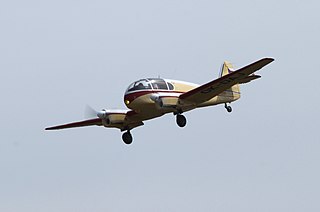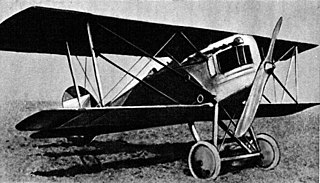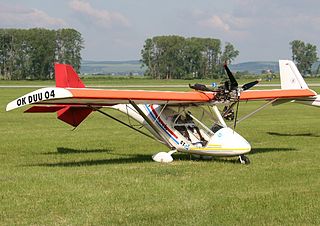
The Aero 45 was a twin-piston engined civil utility aircraft produced in Czechoslovakia after World War II. Aero Vodochody produced the aircraft in 1947–1951, after which the Let Kunovice rolled out these planes until 1961. In 1958 the Ae-45S became the first Czechoslovak plane to cross the Atlantic Ocean. It was the first product of the nation's postwar aviation industry and proved a great success, with many of the 590 produced being exported.

The Aero A.12 was a Czechoslovakian biplane light bomber and military reconnaissance aircraft manufactured in small numbers shortly after World War I. Although reminiscent of the Hansa-Brandenburg-designed aircraft that Aero was building during the war under licence as the Ae.10, the A.12 was the company's own design. It is perhaps most significant as the direct descendant of the highly successful A.11 and its various derivatives. An example of the type is preserved at the Letecké Muzeum in Kbely.

The Aero A.14 was a Czechoslovakian biplane military reconnaissance aircraft built in the 1920s. It was essentially a slightly modified version of the Hansa-Brandenburg C.I aircraft that Aero had built during World War I as the Ae.10, and for this reason, the aircraft is sometimes referred to as the A.14 Brandenburg. When equipped with a slightly different engine, the aircraft was designated A.15 instead. The two versions were otherwise almost identical.

The Aero A.18 was a biplane fighter aircraft built in Czechoslovakia in the 1920s. It was a development of the Ae 02 and Ae 04 fighters Aero had designed during World War I, but also borrowed from the more recent A.11 reconnaissance-bomber design.
The Aero A.21 was a biplane military trainer aircraft developed in Czechoslovakia from the Aero A.11 reconnaissance-bomber. The aircraft was developed specifically as a night-trainer, to teach Czech Air Force pilots instrument flying techniques.

The Aero A.32 was a biplane built in Czechoslovakia in the late 1920s for army co-operation duties including reconnaissance and tactical bombing. While the design took the Aero A.11 as its starting point, the aircraft incorporated significant changes to make it suited for its new low-level role.

The Aero A.34 Kos was a small sports and touring biplane built in Czechoslovakia in the 1930s.

The Aero A.38 was a Czechoslovakian biplane airliner of the 1920s and 1930s. Following the relatively modern A.35, this aircraft was something of a throwback, marrying a fuselage derived from the A.35 to wings copied from the A.23. A few served with CSA, and others with French airline Compagnie Internationale de Navigation Aérienne. These latter aircraft were powered by a French Gnome-Rhône engine instead.

The Aero L-60 Brigadýr was a small, high-wing propeller-driven Czechoslovakian STOL utility aircraft developed for both civil and military use. A prototype, designated XL-60, with Argus As 10C engine, first flew on December 24, 1953, but it was not successful. The plane was thoroughly redesigned and the second improved prototype, with M-208B flat-six engine, flew on June 8, 1954. The aircraft's configuration bears a strong resemblance to the Fieseler Fi 156 "Storch" licence-produced in Czechoslovakia during and after World War II, and which this aircraft was intended to replace. By the end of production in 1960, 273 had been built by Aero, including an improved version, the L-160 with an all-metal tail.

The Let L-200 Morava is a two-engine touring and light passenger aircraft of the 1960s, designed and produced by Let Kunovice in the Czech Republic.

The Zlín Z-XII was a Czechoslovak two-seat sports aircraft, and the first major design success by the Zlínská Letecká Akciová Společnost (Zlín) aircraft manufacturing company, after its founding in Otrokovice after the takeover by the Bata Group.

The Sikorsky S-35 was an American triple-engined sesquiplane transport later modified to use three-engines. It was designed and built by the Sikorsky Manufacturing Company for an attempt by René Fonck on a non-stop Atlantic crossing for the Orteig Prize. It was destroyed in the attempt.

The Early Bird Jenny is an American homebuilt aircraft that was designed by Dennis Wiley and produced by the Early Bird Aircraft Company of Erie, Colorado, also by Leading Edge Airfoils of Peyton, Colorado. When it was available the aircraft was supplied as a kit and also in the form of plans for amateur construction.
The Glassic SQ2000 is an American homebuilt aircraft, designed and produced by Glassic Composites LLC of Sale Creek, Tennessee. When it was available the aircraft was supplied as a kit for amateur construction.
The Henderson Little Bear is an American homebuilt aircraft that was designed and produced by Henderson Aero Specialities of Felton, Delaware, introduced in 1993. The aircraft is a replica of the Piper J-3 Cub. When it was available the aircraft was supplied as a kit or in the form of plans for amateur construction.
The ICP Amigo is an Italian homebuilt aircraft that was designed and produced by ICP srl of Piovà Massaia. When it was available the aircraft was supplied as a kit for amateur construction.

The Letov ST-4 Aztek is a Czech microlight aircraft that was designed and produced by Letov Kbely of Prague - Letňany, in the 1990s. When it was available, the aircraft was supplied as a complete ready-to-fly aircraft, or as a kit for amateur construction.
The Deland Travel Air 2000 is an American homebuilt aircraft that was designed and produced by Orlando Helicopter Airways, an aircraft maintenance and repair company located in DeLand, Florida. When it was available the aircraft was supplied as a kit for amateur construction and marketed under the "Deland" brand, named for the company's location. Plans were also available.
The Tech Aero TR 200 is a French homebuilt aerobatic aircraft that was designed and produced by Tech Aero of Glisolles, first flown in August 1988. When it was available the aircraft was supplied as a kit for amateur construction.

The InterPlane Starboy was a proposed Czech homebuilt aircraft designed by InterPlane Aircraft of Zbraslavice. The aircraft was intended to be supplied as a complete ready-to-fly-aircraft or as a kit for amateur construction, but none seem to have been built.














